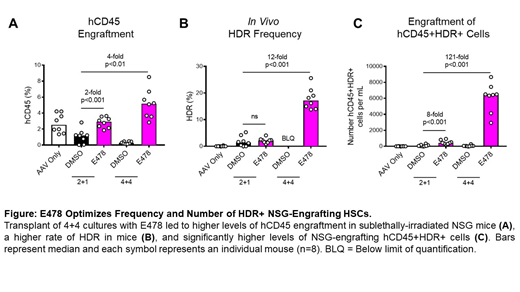Background. Site-specific gene correction of hematopoietic stem cells (HSCs) via homology directed repair (HDR) has the potential to precisely repair defective genes and provide life-long cures for a variety of blood-based diseases. It is possible to obtain high levels of HDR during in vitro HSC culture, but these cells fail to robustly engraft in vivo, suggesting that the procedure of HDR compromises HSC function or that true HSCs are not undergoing HDR. Cells need to be actively cycling in order to undergo HDR, but conditions that allow HSC replication in vitro without compromising HSC number and function remain elusive. Thus, most HDR protocols minimize time in culture, potentially limiting HDR rates and cell yield. We recently reported that ex vivo expansion of HSCs with an aryl hydrocarbon receptor (AHR) antagonist is a clinically validated method to expand HSCs. The AHR antagonist-expanded CD34+ cell therapy, MGTA-456, results in rapid and durable recovery in patients with hematologic malignancies and inherited metabolic diseases (Wagner et al Cell Stem Cell 2016; Orchard et al AAN 2019).
To apply this technology to gene-modified HSCs, we developed a novel AHR antagonist, E478, which expands NSG-engrafting cells 10-fold compared to uncultured primary human mobilized peripheral blood (mPB) CD34+cells in limit dilution studies. We previously showed that expansion with E478 results in up to 10-fold higher engraftment of lentiviral vector (LVV)-transduced cells and CRISPR/Cas9 knockout cells (Hoban et al ASGCT 2019). Here, we demonstrate that ex vivo expansion of mPB CD34+ cells with E478 results in >10-fold increase in rate of HDR and >120-fold increase in NSG engraftment of HDR+ cells compared to conventional approaches.
Results. To determine whether more active cycling would lead to higher rates of HDR, we cultured cells for 1, 2, 3, and 4 days prior to electroporation with CRISPR gRNA targeting the beta-globin gene and transduction with a GFP-containing adeno-associated virus (AAV) donor template. Cell cycle analysis revealed that 33±1.8% of cells enriched for HSCs (CD34+CD90+ cells) remain quiescent after 2 days in culture, whereas 0.92±0.06% of CD34+CD90+ cells were quiescent after 3 and 4 days in culture (n=2 mPB donors). We then assessed HDR rates and HSC number after 1, 2, 3, and 4 days of additional culture. Compared to a conventional HDR protocol utilizing a 2-day pre-stimulation period followed by 1 day of culture after electroporation (herein called a 2+1 culture), we observed up to 8-fold increase in HDR with longer pre-stimulation periods, but this was accompanied with differentiation of CD34+CD90+ cells and loss of engraftment in NSG mice (79% decrease, p<0.001).
We next evaluated whether E478 could increase the dose of HSCs and maintain high HDR rates. We cultured mPB CD34+ cells with E478 for a 4 day pre-stimulation, performed HDR, and continued the expansion for 4 days with E478 (herein called 4+4 culture). With the 4+4 protocol, we observed a 6-fold increase in the rate of HDR in vitro and a 134-fold increase in the number of CD34+CD90+ cells with E478 relative to 2+1 conditions with DMSO vehicle (n=2, p<0.01). Transplant of these cells into sublethally-irradiated NSG mice resulted in a 4-fold higher rate of engraftment (Figure A, p<0.01, n=8 mice), 12-fold higher rates of HDR (Figure B, p<0.001) and >120-fold increase in the number of HDR+ NSG-engrafting cells relative to 2+1 cultures (Figure C, p<0.001). Further, a 2+1 culture with E478 led to an 8-fold increase in number of HDR+ NSG-engrafting cells (p<0.001) relative to standard 2+1 approaches without a small molecule. Multi-lineage engraftment was observed in all groups. Studies using E478 with bone marrow from patients with sickle cell disease are in progress and will be presented.
Conclusions. We demonstrate that ex vivo HSC expansion with E478 enables higher rates of HDR and a high dose of HDR+ HSCs, leading to >120-fold increase in the engraftment of HDR+ HSCs compared to conventional 2+1 approaches. Culture with E478 is a promising approach to realize the full potential of targeted gene correction in HSCs for a variety of genetic diseases.
Goncalves:Magenta Therapeutics: Employment, Equity Ownership, Patents & Royalties. Hoban:Magenta Therapeutics: Employment, Equity Ownership. Hyzy:Magenta Therapeutics: Employment, Equity Ownership. George:Magenta Therapeutics: Employment, Equity Ownership. Boitano:Magenta Therapeutics: Employment, Equity Ownership, Patents & Royalties. Cooke:Magenta Therapeutics: Employment, Equity Ownership, Patents & Royalties.
Author notes
Asterisk with author names denotes non-ASH members.


This feature is available to Subscribers Only
Sign In or Create an Account Close Modal